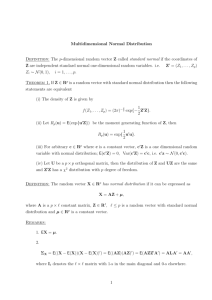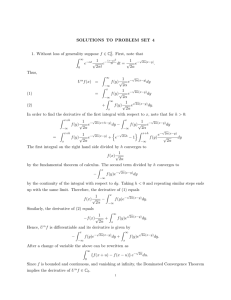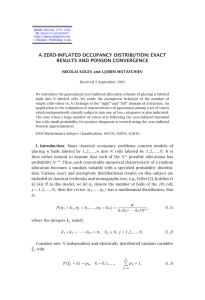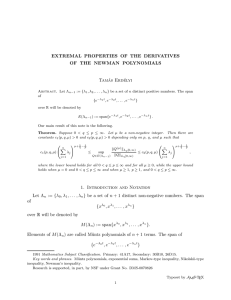1 Order Statistics
advertisement
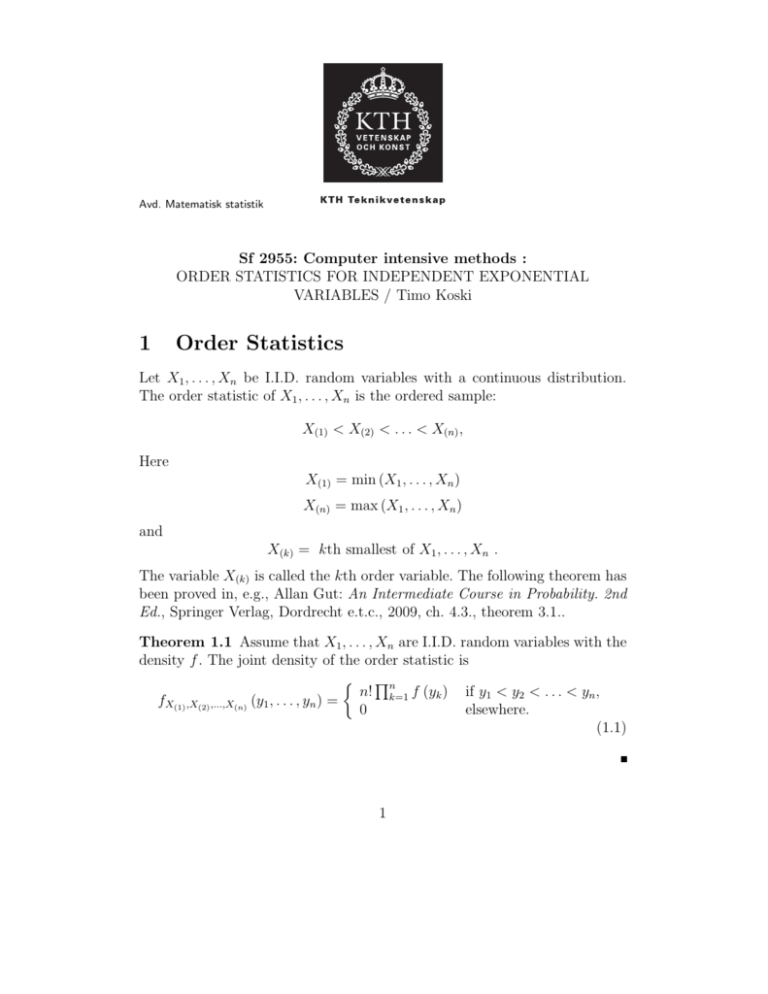
Avd. Matematisk statistik Sf 2955: Computer intensive methods : ORDER STATISTICS FOR INDEPENDENT EXPONENTIAL VARIABLES / Timo Koski 1 Order Statistics Let X1 , . . . , Xn be I.I.D. random variables with a continuous distribution. The order statistic of X1 , . . . , Xn is the ordered sample: X(1) < X(2) < . . . < X(n) , Here X(1) = min (X1 , . . . , Xn ) X(n) = max (X1 , . . . , Xn ) and X(k) = kth smallest of X1 , . . . , Xn . The variable X(k) is called the kth order variable. The following theorem has been proved in, e.g., Allan Gut: An Intermediate Course in Probability. 2nd Ed., Springer Verlag, Dordrecht e.t.c., 2009, ch. 4.3., theorem 3.1.. Theorem 1.1 Assume that X1 , . . . , Xn are I.I.D. random variables with the density f . The joint density of the order statistic is Qn n! k=1 f (yk ) if y1 < y2 < . . . < yn , fX(1) ,X(2) ,...,X(n) (y1 , . . . , yn ) = 0 elsewhere. (1.1) 1 2 Exponential Order Variables Let X1 , . . . , Xn be I.I.D. random variables with distribution Exp(θ). Thus the density function of each Xi is 1 −x/θ e if x ≥ 0 θ f (x; θ) = (2.2) 0 if x < 0. We are interested in the differences of the order variables X(1) , X(i) − X(i−1) , i = 2, . . . , n. Note that we may consider X(1) = X(1) − X(0) , if X(0) = 0. We shall next show the following theorem. Theorem 2.1 Assume that X1 , . . . , Xn are I.I.D. random variables under Exp(1). Then (a) X(1) 1 1 , X(i) − X(i−1) ∈ Exp , ∈ Exp n n+1−i (b) X(1) , X(i) −X(i−1) for i = 2, . . . , n, are n independent random variables. Proof: We define Yi for i = 1, . . . , n by Y1 = X(1) , Yi = X(i) − X(i−1) . Then we introduce A= so that if 1 −1 0 .. . 0 Y= 0 1 −1 .. . 0 Y1 Y2 Y3 .. . Yn 0 0 0 0 0 0 . .. .. ... . . 0 . . . −1 1 0 0 1 .. . ... ... ... , X = 2 X(1) X(2) X(3) .. . X(n) , (2.3) we have Y = AX. It is clear that the inverse matrix A−1 exists, because we can uniquely find X from Y by X(1) = Y1 , X(i) = Yi + Yi−1 + . . . + Y1 . We write these lastmentioned equalities in matrix form by X = A−1 Y. Then we have the well known change of variable formula (se Gut work cited chap I) 1 . (2.4) fY (y) = fX A−1 y | det A| But now we evoke (1.1) to get fX A−1 y = n!f (y1 ) f (y1 + y2 ) · · · f (y1 + y2 + . . . + yn ) , (2.5) since y1 < y1 + y2 < . . . < y1 + y2 + . . . + yn . As f (x) = e−x , we get f (y1 ) f (y1 + y2 ) · · · f (y1 + y2 + . . . + yn ) = e−y1 e−(y1 +y2 ) · · · e−(y1 +y2 +...+yn ) and rearrange and use y1 = x(1) and yi = x(i) − x(i−1) , = e−ny1 e−(n−1)y2 · · · e−2yn−1 e−yn = e−nx(1) e−(n−1)(x(2) −x(1) ) · · · e−(x(n) −x(n−1) ) . Hence, if we insert the last result in (2.4) and distribute the factors in n! = n(n − 1) · · · 3 · 2 · 1 into the product of exponentials we get fY (y) = ne−nx(1) (n − 1)e−(n−1)(x(2) −x(1) ) · · · e−(x(n) −x(n−1) ) 1 | det A| (2.6) Since A in (2.3) is a triangular matrix, its determinant equals the product of its diagonal terms, c.f. L. Råde and B. Westergren: Mathematics Handbook for Science and Engineering, Studneetlitteratur, Lund, 2009, p. 93. Hence from (2.3) we get det A = 1. In other words, we have obtained fX(1) ,X(2) −X(1) ,...,X(n) −X(n−1) x(1) , x(2) − x(1) , . . . , x(n) − x(n) 3 = ne−nx(1) (n − 1)e−(n−1)(x(2) −x(1) ) · · · 2e−2(x(n−1) −x(n−2) ) e−(x(n) −x(n−1) ) . (2.7) But, checking against (2.2), ne−nx(1) is the probabilty density of Exp n1 , (n− 1 1)e−(n−1)(x(2) −x(1) ) is nothing but the probability density of Exp n−1 , and so −(n+1−i)(x(i) −x(i−1) ) on, the generic factor in the product in (2.7) being (n+1−i)e , 1 which is the density of Exp n+1−i . Hence we have that the product in (2.7) is a product of the respective 1 probabilitydensities for the variables X(1) ∈ Exp n and for X(i) − X(i−1) ∈ 1 . Thus we have established the cases (a) and (b) in the theorem Exp n+1−i as claimed. As is well known, there is also a more intuitively appealing way of seeing this result. First one shows that 1 X(1) = min (X1 , . . . , Xn ) ∈ Exp n (which is also seen above), if X1 , . . . , Xn are I.I.D. random variables under Exp(1). Then one can argue by independence and the memorylessness property of the exponential distribution that X(i) − X(i−1) is the minimum of lifetimes of n + 1 − i independent Exp(1) -distributed random variables. 4






